#Jayadeva
Text
Mystic Poetry of Sant Jayadeva from the Adi Granth and Gita Govinda - Spiritual Awakening Radio Podcasts

Says Sant Jayadeva: "In the very beginning was the Primal Lord, unrivaled, the Lover of Truth and other virtues. He is absolutely wonderful, transcending creation; remembering Him, all are emancipated. Within my mind, I chant the Name of the Primal Lord God, the Source of virtue. My vision, that You are I are separate, has melted away."
Sant Jayadeva is one of the earliest Sants known to history. Jayadeva was born during 1170. He's known to the Sikh tradition as Bhagat Jaidev. He was a Sanskrit "loner-poet" who lived during the 12th century and is celebrated for his poetic genius in eastern India. He is the author/composer of the epic poem known as Gita Govinda (The Hymn to the Custodian of Light). Sant Jayadeva is the earliest dated author of hymns that are included the Adi Granth! Today during this Sant Mat Satsang Podcast you'll hear readings from, Unveiling the Garden of Love -- Mystical Symbolism in Layla Majnun and Gita Govinda (Sufi Mysticism and the Teachings of Sant Jayadeva in the Gita Govinda). And then, I share readings from the Mystic Verses of Sant Jayadeva: Gurbani by Bhagat Jaidev in the Adi Granth, one of the earliest known Sants: Hymn # One on Page 526 of the Adi Granth with commentary, followed by the reading of Hymn # Two on page 1106 with commentary.
Spiritual Awakening Radio Podcast - Mystic Poetry of Sant Jayadeva from the Adi Granth and Gita Govinda - Listen/Download @ the Podcast Website:
https://SpiritualAwakeningRadio.libsyn.com/mysticpoetryofsantjayadevafromtheadigranthandgitagovinda
@ Direct MP3 Download:
https://traffic.libsyn.com/spiritualawakeningradio/Mystic_Poetry_of_Sant_Jayadeva.mp3
Listen @ Apple Podcasts:
https://podcasts.apple.com/us/podcast/mystic-poetry-of-sant-jayadeva-from-the-adi-granth/id1477577384?i=1000620740899
@ Spotify:
https://open.spotify.com/embed/show/5kqOaSDrj630h5ou65JSjE
@ Google Podcasts:
https://podcasts.google.com/feed/aHR0cHM6Ly9mZWVkcy5saWJzeW4uY29tLzIwNzIzNi9yc3M/episode/ZDA4YzVlZWItZDU3ZS00NDI0LThjMDAtZDMxZmZhZjQ5Yzky?sa=X&ved=0CCEQz4EHahcKEwio84DRp4aAAxUAAAAAHQAAAAAQAQ
& @ Wherever You Subscribe and Follow Podcasts (Apple, Spotify, Google Podcasts, Amazon, Audible, PodBean, Overcast, Jio Saavan, iHeart Radio, Podcast Addict, Gaana, CastBox, etc...):
https://linktr.ee/SpiritualAwakeningRadio
In Divine Love (Bhakti), Light, and Sound, At the Feet of the Masters, Radhaswami,
James Bean
Spiritual Awakening Radio Podcasts
Sant Mat Satsang Podcasts
A Satsang Without Walls
Sant Mat Radhasoami
https://www.SpiritualAwakeningRadio.com
#wordpress#podcasts#jayadeva#gita govinda#spirituality#meditation#sants#india#scriptures#spiritual awakening radio#satsang#sant mat#radhasoami
7 notes
·
View notes
Text
bahu manute nanute tanu sangata pavana chalitamapirenum
-He admires even the breeze passing over you and reaching him. (Jayadeva kriti)
3 notes
·
View notes
Text
Venerating Jayadeva's Gita Govinda: Its Enduring Impact on Odia Culture and Arts #BlogchatterA2Z
Venerating Jayadeva's Gita Govinda: Its Enduring Impact on Odia Culture and Arts #BlogchatterA2Z #GitaGovinda #Jayadeva #OdiaCulture #OdissiDance #BhaktiMovement #SanskritLiterature #OdishaFestivals #JagannathTemple #IndianClassicalArts #SpiritualOdisha
Illuminating the Divine: The Profound Impact of Jayadeva’s ‘Gita Govinda’ on Odia Culture
Introduction:Jayadeva’s ‘Gita Govinda’ is not just a literary masterpiece but a cornerstone of Odia culture and spirituality. Composed in the 12th century by the saint-poet Jayadeva, this Sanskrit text is a lyrical fusion of profound spirituality and sublime poetry. It celebrates the divine love of Krishna…
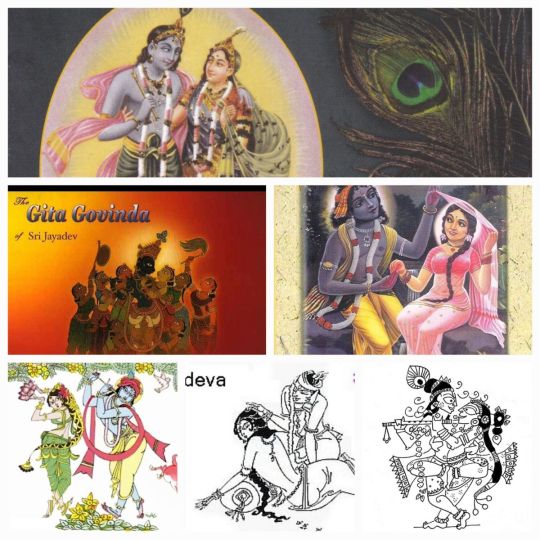
View On WordPress
#Bhakti movement#Gita Govinda#Indian classical arts#Jagannath Temple#Jayadeva#Odia Culture#Odia music#Odissi dance#Religious practices in Odisha#Sanskrit literature
0 notes
Text
Wireless Water Level Controller Bangalore: 9379111110
Wireless Automatic Water Level Controller Dealers/Distributors/Suppliers/Manufacturers & Installation in Bangalore: 9379111110_ Bannerghatta Road, JP Nagar, Marathahalli, Btm Layout, Electronic City, Koramangala, RT Nagar, Vijayanagar, Bellandur, Banashankari, Jayanagar, Jayadeva, MG Road, Sivaji Nagar, Whitefield, ITPL, Banaswadi, Hebbal, Kundalahalli, Kaggadasapura, KR Puram, Kammanahalli, Old Airport Road, Rajarajeshwari Nagar, Ramamurthy Nagar, Rajajinagar, SP Road, Gottigere, Hulimavu, HSR Layout, Arekere, HAL, Domlur, Indira Nagar, Halasuru, CMH Road, Old Madras Road, Tin Factory and anywhere in Bangalore.
#Wireless Automatic Water Level Controller Dealers/Distributors/Suppliers/Manufacturers & Installation in Bangalore#Bannerghatta Road#JP Nagar#Marathahalli#Btm Layout#Electronic City#Koramangala#RT Nagar#Vijayanagar#Bellandur#Banashankari#Jayanagar#Jayadeva#MG Road#Sivaji Nagar#Whitefield#ITPL#Banaswadi#Hebbal#Kundalahalli#Kaggadasapura#KR Puram#Kammanahalli#Old Airport Road#Rajarajeshwari Nagar#Ramamurthy Nagar#Rajajinagar#SP Road#Gottigere#Hulimavu
1 note
·
View note
Text
Best Auditors in Bangalore: Call @ 9844713239.
Aradhya Associates is a Leading Chartered Accountants(Auditors) firm in Bangalore Call @ 9844713239. Bannerghatta Road, JP Nagar, Marathahalli, Btm Layout, Electronic City, Koramangala, RT Nagar, Vijayanagar, Bellandur, Banashankari, Jayanagar, Jayadeva, MG Road, Sivaji Nagar, Whitefield, ITPL, Banaswadi, Hebbal, Kundalahalli, Kaggadasapura, KR Puram, Kammanahalli, Old Airport Road, Rajarajeshwari Nagar, Ramamurthy Nagar, Rajajinagar, SP Road, Gottigere, Hulimavu, HSR Layout, Arekere, HAL, Domlur, Indira Nagar, Halasuru, CMH Road, Old Madras Road, Tin Factory and anywhere in Bangalore.
#Aradhya Associates is a Leading Chartered Accountants(Auditors) firm in Bangalore Call @ 9844713239. Bannerghatta Road#JP Nagar#Marathahalli#Btm Layout#Electronic City#Koramangala#RT Nagar#Vijayanagar#Bellandur#Banashankari#Jayanagar#Jayadeva#MG Road#Sivaji Nagar#Whitefield#ITPL#Banaswadi#Hebbal#Kundalahalli#Kaggadasapura#KR Puram#Kammanahalli#Old Airport Road#Rajarajeshwari Nagar#Ramamurthy Nagar#Rajajinagar#SP Road#Gottigere#Hulimavu#HSR Layout
0 notes
Text
Baishnab Padabali by Sukumar Sen PDF
Baishnab Padabali edited by Sukumar Sen PDF
Book – Baishnab Padabali (Vaishnava Padavali),
Edited by Sukumar Sen,
Format – PDF,
PDF Size – 4 MB,
Book Pages – 112,
Genre – Anthology Books (Edited Books),
Sukumar Sen, one of the literary linguists of Bengali literature, wrote the book Baishnab Padabali (Vaishnava Padavali).
Baishnab Padabali (Vaishnava Padavali) first appeared in Bengal after the…
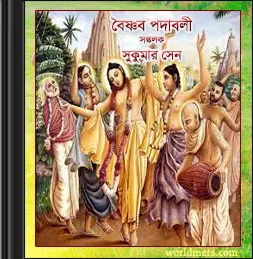
View On WordPress
0 notes
Photo

Get complete details about Santhome School of Nursing, Bangalore: Courses, Admissions, Facilities, etc. Reserve Your Seat Now!
#sri jayadeva institute of cardiovascular sciences and research#sri jayadeva institute of cardiovascular sciences and research course admissions#Sjicr
0 notes
Text
AIIMS, Jayadeva institute to boost medical infrastructure at Karnataka's Hubballi-Dharwad
AIIMS, Jayadeva institute to boost medical infrastructure at Karnataka’s Hubballi-Dharwad
AIIMS, Jayadeva institute to boost medical infrastructure at Karnataka’s Hubballi-Dharwad
The state government has already announced the setting up of a regional centre of the Jayadeva Institute at the cost of Rs 250 crores for which 10 acres of land have been identified.
The state government has already announced the setting up of a regional centre of the Jayadeva Institute at the cost of Rs…
View On WordPress
0 notes
Text
Krishna: a character adored for over two thousand years, revered as one of the most significant political masterminds of the ancient world with his words forming the philosophical core of the country today. Concurrently, he is the god shrouded in inimitable domesticity- as a friend, a lover, and a child. No other deity in the Hindu pantheon has probably achieved as dear a position in the hearts of people as this flute-wielding cowherd of Gokula.
For generations, he has shined as the muse of countless poetfolk, of unfinished business, of unspoken desires and of repressed lovers' qualms. In Meera's longing for her marble beloved, and in Kothai's dulcet dreams of a celestial wedding, Krishna blossoms not as a warrior, but rather as a confidante of young women- the keeper of all secrets.
Curse, o ye, this wedding of devotion,
For I was better off unmarried,
Writes the lovestruck Nawab Sadiq Hilm,
I was well enough at my mother's;
Oh, why did I pine for him?!
Who am I, or what: go ask Rizwan, the gatekeeper
For heaven has been rejected by my forebearers!
He says, in a nostalgic ode to the cowmaids from old tales. To the ones that massage the dust off their feet on Krishna's fevered forehead to soothe his illness, even as the apparent disrespect dooms their afterlives.
Jayadeva notes a more rugged form of Krishna, one that is almost hungry for love. His Radha smiles down upon Radharaman Dutta's kalankini. Of course, she would accept even infamy if it was in relation to her Krishna. However, in time, this epithet has been reclaimed as a celebration of the meteoric, tempestuous love that this unseemly duo had carved out for themselves of the pages of a mostly unwilling history.
Tagore's Krishna is mysterious, eagerly anticipated but rarely seen. Rather, here Radha's pining is crushing and all-encompassing, inherited from Chandidas' virahini. Radha's guttural desire to transform Krishna into herself, subjecting him to the same suffering that she undergoes as a woman in love with a furious ideology more than a man, reverberates eerily against the lighthearted cross-dressing tale of Surdas'.
As often as bards favour the songs extolling the love of the cowherd and the wedded maiden, Krishna's wives are seldom accorded any thought outside of Vasudeva's family tree. Their silence speaks to the stringent rules of a typical patriarchal household. Some of them do speak, and hence Satyabhama becomes conceited and Kalindi wayward. However, the mere few lines that they are mercifully allotted in the text are enough to speak to their resilience. The lines inadvertently hold up a window to the million unspoken words and unexchanged glances. It speaks to the long years, happy and sad. It speaks to the nights of waiting for the beloved to return. It speaks to the quiet lunches in curtained rooms and taste tests in the kitchen.
Each of Krishna's eight wives has their own life, and their own equation with Krishna. Each of their distinct personalities, coupled with their unique introductions to the prince has the potential to bring a distinct flavour to the story of Krishna, the statesman. The understanding that Krishna's heart belonged first to Vrindavana and then to his ambition, must have weighed somewhat on their hearts and yet, the choice to patch up the battle-hardened cowherd, after every blow, sans complaint, and send him out into the world as the architect of history, must have demanded restraint.
The distinct turn of events that brings each of the chief eight queens to Krishna's is quite interesting. Rukmini, the first, demonstrates heart, even if it is born out of desperation. Seizing control of her life, she sends a message, relying solely on rumours of his compassion. Her gamble yields returns manifold as Krishna not only rescues her from an unwanted marriage, but instates her as his chief consort, elevating her, alongside himself, to a divine status. Far from the impulsiveness of her youth, Pandhari's Rakhumai, astute beside her beloved, proudly bears a conch-shell, calling for harmony and community. In life as well, Rukmini brings to Krishna much needed stability, and oversees the blossoming of the city of Dwarika as well as Krishna's growing household.
Jambavati and Satyabhama are given in marriage to the prince by their respective fathers and do not seem to have much of a voice at the time. Jambavati fulfills an ancient destiny, a forgotten promise, then going on to mother the child that ultimately brings about the demise of the Yadava clan. Satyabhama, though often maligned with unfair accusations, is self-reliant. Making no attempt to hide herself from the eye of society, takes her rightful place beside Krishna, not on a throne, but by his side in battlefields. Kalindi however, is an extremely interesting character in Krishna's story. Enmeshed between mortal and divine, she exists as neither. Chancing upon the prince, she unabashedly declares her intentions to be married, and yet she is uncharacteristically silent after her marriage. Lakshmana and Mitravinda, are both won in conquest. They might have been able to sympathize with Rukmini, given their kin had turned against them, on account of their choice of a life partner. Bhadra, on the other hand, has no fancy contests to boast of, or an adventurous rescue. She marries Krishna at the behest of her brother, the only highlight being the arduous journey she undertakes from Kekaya to Dwarika.
After their marriages, these women practically disappear from the narrative until their last moments. We can assume that they were all presumably content with a life outside the spotlight. One can only hope to be privy to their lives after marriage, to know their dreams, nightmares and daily chores. They enter Krishna's life at crucial junctions, and I choose to believe they each had a unique effect on Krishna's worldview, bringing with them a fresh outlook into the mostly stagnant golden city.
#krishna#radha#original writing#mahabharata#hindu mythology#rukmini#satyabhama#kalindi#desi tumblr#ehi murare#prologue#jambavati#mitravinda#lakshmana#bhadra#nagnajiti
153 notes
·
View notes
Photo

As Passion Took Over,
c. 1775-1780
Indian, Unknown
Page from a dispersed series of the Gita Govinda (Song of the Dark Lord) of Jayadeva
156 notes
·
View notes
Text
I'll get so much hate for this but idc. Just read through before spewing brain rot. Open to discuss obviously.
I need y'all to stop with this cultural appropriation shit with bharatanatyam.
For people who don't know the discourse,
"Bharatanatyam is a culturally appropriated and sanitised form of Sadir-attam, a dalit art form".
Wrong on many levels.
1. Bharatanatyam is not the same as sadir. Sadir is considered a precursor but today's Bnat dancers are NOT dancing Sadir. In fact I can say that it is not even Natyam we are doing but that's another discourse
2. Sadir and devadasi/mahari culture was never dalit specific. Members of all castes learnt dance. Padmavati, Jayadeva's wife, was a devadasi and the daughter of a priest. Shantala Devi, the queen of the Hoysalas, was a former devadasi. I forgot the name but an Odia king (simha something. I read it for my junior exam) was a dancer. @ramayantika will know who I'm talking about being an odissi dancer. Y'all can be delulu about this but the proof is literally engraved in stone.
3. Bnat cannot be said is appropriating Sadir items into its fold with hundred percent certainty. Many of the items we perform now are introduced very recently. Many are taken from Kuchipudi. And Sadir itself is a product of Natyashastra. Devadasis danced to padams and javalis written by Brahmins.
5. Upper caste girls are predominantly dancers cos maybe they are the ones who stay in class. Y'all haven't had to sit on a desk convincing a parent to keep their recently "matured" daughter in class or try to tell them that boys can dance too (cos you naively assume misogyny) and them telling you in their caste "oNLy PrOstITuTes DaNcE".
And the worst part is y'all won't know shit about these things if you don't attend classes. This is not something you will find in Quint or whatever. You have to be there to know it.
Don't think that I am in any way denying casteism. I am way too well-read to do that shit atp and I have seen enough. But y'all wanna talk about caste in dance, talk about how lcs can't afford to attend classes because of systemic economic difficulties. Talk about stagnated uc male centric narratives in abhinaya pieces. Talk about the rampant superstitions and misogyny that keeps lc students from pursuing their art. Talk about the nepotism in the field and how it makes the system inherently rigged against outsiders, especially lcs who can't even claim a surname. Those are conversations worth having. Not your hot-takes with no basic fact checking.
13 notes
·
View notes
Text
RādhāKṛṣṇa

O woman with desire, place on this patch of flower-strewn floor your lotus foot,
And let your foot through beauty win,
To me who am the Lord of All, O be attached, now always yours.
O follow me, my little Radha.
— Jayadeva, Gita Govinda
18 notes
·
View notes
Text
Dedicating this to Nandini.
youtube
ഗോപികേ . . . ഹൃദയമൊരു വെണ്ശംഖു പോലെ
തീരാ വ്യഥകളില് വിങ്ങുന്നുവോ? (2) Cow herdess . . . is your heart throbbing in endless agony like a white conch? ഏതോ വിഷാദമാം സ്നേഹാര്ദ്ര സാഗരം
ഉരുകീ നിന്റെ കരളിൽ (ഗോപികേ. . . ) The melancholic ocean of tender love melted in your heart.
ഏതോ വിഭാതം പാടും സോപാന ഗാനം പോലെ. Like the sopana song sung by the early morning, [Sopana sangeetham is a form of ritual music in the temples of Kerala, during closing and opening. The songs from Jayadeva's Geeta Govindam are usually used in this.]. ഗന്ധര്വ്വ ഹൃദയം മീട്ടും ഹിന്ദോള രാഗം പോലെ
Like the hindola ragam played by the gandharvas' heartstrings,
പ്രണയാര്ദ്രമായീ നിന് മാനസം
Your heart was mellowed by love.
ഒരു പൂര്ണ്ണ ചന്ദ്രോദയം കടലിന്റെ അലമാലയെ
പുണരുന്ന പോലെ സ്വയം മറന്നുവോ? (ഗോപികേ. . . )
Did you forget yourself like the full moon longing to hug the waves of the sea?
ധ്യാനിച്ചു നില്ക്കും പൂവില്
കനല് മിന്നല് ഏല്ക്കും രാവിൽ,
On the night that the hot lightning strikes the meditating flower,
ഗാനം ചുരത്തും നെഞ്ചിന് മൃദുതന്തി തകരും നോവില്,
In the pain of the soft strings of the singing heart getting broken,
ഏകാന്തമായീ നിന് ശ്രീലകം.
Your sanctum sanctorum has become empty.
ഒരു സ്വര്ണ്ണ ദീപാങ്കുരം കാറ്റിന്റെ നെടുവീര്പ്പിനാൽ
പിടയുന്ന പോലെ സ്വയം പൊലിഞ്ഞുവോ?(ഗോപികേ. . . )
Did you extinguish yourself like a golden flame trembling in the sighs of the wind?
Film: Nandanam
Lyrics: Gireesh Puthancherry
Music: Raveendran
Singer: K J Yesudas
7 notes
·
View notes
Text

In the Gīta-govinda, by Jayadeva Gosvāmī, one gopī tells her friend, “Kṛṣṇa is the reservoir of all pleasure within this universe. His body is as soft as the lotus flower. And His free behavior with the gopīs, which appears exactly like a young boy’s attraction to a young girl, is a subject matter of transcendental conjugal love.” A pure devotee follows in the footsteps of the gopīs and worships the gopīs as follows: “Let me offer my respectful obeisances to all the young cowherd girls, whose bodily features are so attractive. Simply by their beautiful attractive features they are worshiping the Supreme Personality of Godhead, Kṛṣṇa.” Out of all the young gopīs, Śrīmatī Rādhārāṇī is the most prominent.
(text pasted from theharekrishnamovement.org)
3 notes
·
View notes
Text
Rabindra Geeti by Jaydeb Ray PDF
Rabindra Geeti by Jaydeb Ray Bengali PDF.
Book – Rabindra Geeti,
Author – Jaydeb Ray,
Genre – Biographical book,
Language – Bengali,
Book Format – PDF,
Book Size – 7 MB,
writer Jaydeb Ray wrote the biographical book Rabindra Geeti.
The book Rabindra Geeti was originally written about the world poet Rabindranath Tagore. In this book, the author has presented clear ideas and discussions about…
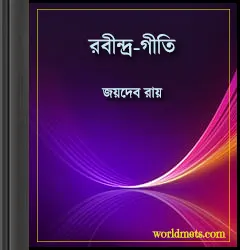
View On WordPress
0 notes
Text
The year that was...
“Slippery slope. I carry a spare shirt, pretty soon I’m carrying spare pants. Then I’d need a suitcase. Next thing I know, I’ve got a house and a car and a savings plan and I’m filling out all kinds of forms.”
—Jack Reacher (in Lee Child’s 2007 novel Bad Luck and Trouble)
For close to a year, I have been fortunate to be part of the Saturday morning conversazione that takes place in the office of Dr. S R Ramaswamy (SRR), who is more than a mentor to me. In one of the early meetings of 2023, SRR gave me his personal copies of two Jack Reacher novels (by James Dover Grant, who writes under the pseudonym Lee Child) and added with a smile, "I must warn you, these are addictive!"

A few days after that, I was going to be on a long train to Pune and had taken the novel with me. Even before we crossed the Karnataka border, I had finished reading the novel and cursed myself for not having brought the other one too (which was a result of my underestimation of my own reading speed). As soon as I came back to Bangalore, I raced through the other novel. When I returned the two novels to SRR, he gave me more. It had been years since I had read fiction and given that my day job involves reading, writing, design, and publication, I had forgotten the art of reading for pleasure. This gesture on SRR's part rekindled that spark. The flipside was that I started finding films and web series tiresome!
I mostly read Jack Reacher novels this year and what fascinated me the most (besides the intricate plots, value conflicts, and the edge-of-the-seat twists and turns) was the universal appeal of a character like Reacher who lives like a monk and fights like a tiger; even in the materialistic West the allure of a man who is detached and driven by a strong sense of dharma is irresistible. And that gives me hope.
#
Soon I will hit forty. Probably my best years are behind me but I like to believe that they are yet to come. To augment this belief, I lay out my plans for 2024 before getting into my recollections of 2023.
I have three short-term goals, which I wish to complete in the next six months:
i. Organise my library
ii. Simplify my wardrobe
iii. Consolidate my finances
and four lifestyle goals that I wish to continue through the year:
1. Exercise daily
2. Read more, and more varied books
3. Play the violin more
4. Avoid sugar and fried foods at all costs
Some of the books in the pipeline for this year are: A R Krishnasastri’s Kathāmṛta, a new edition of Bhāsa’s Svapna-vāsavadatta, D V Gundappa’s Jīvana-dharma-yoga translated by Raghavendra Hebbalalu and Sreelalitha Rupanagudi, Volumes VII and VIII of DVG’s Art Gallery of Memories, S R Ramaswamy’s Silhouettes of Excellence, Sripriya Srinivasan’s book on Pallava history for high school students, minor poems of Nīlakaṇṭha-dīkṣita, and Jayadeva’s Gīta-govindam, among others.
I'm also working on a few exciting projects with cousin Dr. Chandra Shekhar (a short stories anthology), my college classmate Sudarshan K A (on financial wisdom), and with my friends Ganesh Bhat Koppalatota and Neelakanth Kulkarni (curating the best of Kannada literature), and I hope that at least a few of these see completion by end of the year.
#
I was lucky to have a front row seat as the following books unfolded through the course of the year: Three volumes of DVG's Kannada writings in translation (Contemporaries of Vidyaranya, his writings on the two epics of India, and an anthology of his essays on poetics), Vols. V and VI of the Art Gallery of Memories by DVG, Śatāvadhānī Dr. R Ganesh's Kṣāttra: The Tradition of Valour in India, and Dr. L Subramaniam's Festival Beyond Borders, among others.
I was able to facilitate the publication of three books by family members: my mother's booklet of life-lessons titled Song of my Soul, my father's monograph on The Amazing Human Mind, and my great-uncle (Late) Sri S Rangarajan's mammoth 648-page memoirs titled It Happens as Ordained.
The highlight, however, was a little book that I co-wrote with Dr. Ganesh titled The Essential Sanatana Dharma.

In addition to working on a few books in 2023, I was also invited to give lectures on a variety of topics, some of which were at the insistence of Dr. Arathi V B who has often magnanimously offered me opportunities that are far beyond my ken. If my calculations are right, I must have given no less than eighteen lectures this year. Friends like Madhulika Srivatsa, Sagar Mehta, and Vani Anur invited me to their homes to give lectures to their family and friends, which were highly rewarding.
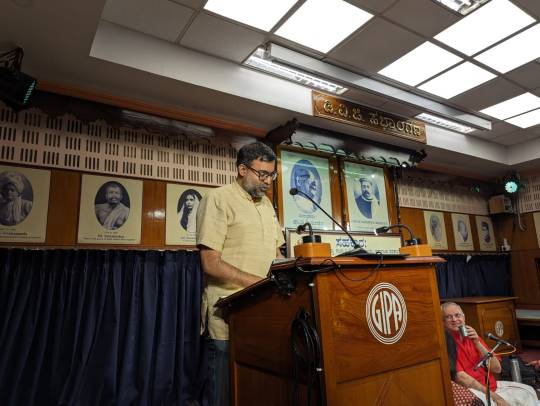
I had the singular fortune of addressing a large number of school children, teachers, young parents, devout Hindus, et al. on topics as varied as life skills to the essentials of Sanātana-dharma; from the importance of history and heritage to world musical genres (at an elders' enrichment centre); from Indian Knowledge Systems to the Art Gallery of Memories (series of lectures at the Gokhale Institute of Public Affairs); and on the Artha-śāstra, Mahābhārata, Bhagavad-gītā, and Śrīkṛṣṇa-karṇāmṛta.
#
For more than two decades I have been attending the Lakshminarayana Global Music Festival (LGMF) organised by my guru Dr. L Subramaniam (along with his wife, Smt. Kavita Krishnamurti, who is the director of the festival); for some years, I was also active in the organising committee of the festival. Each edition of the LGMF has been a historic event and 2023 was no different. The upcoming tour is no less exciting with a remarkable orchestra from Kazakhstan visiting India.
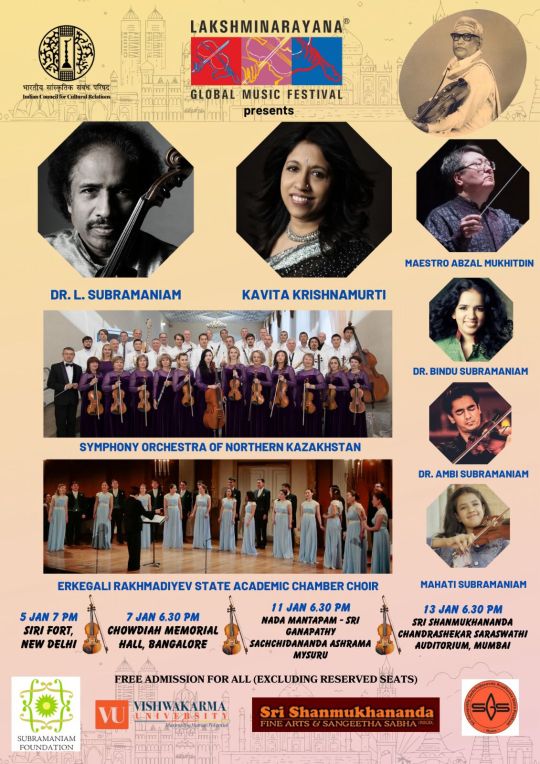
Some of the other memorable events that I attended in 2023 include the third edition of Madanotsava organised by my good friends Nirupama and Rajendra, the eightieth birthday celebrations of Dr. Padma Subrahmanyam organised by Drishti Arts Centre, the fifth World Coffee Conference (thanks to my friend Ananth Bhatt), and a lovely eighty-fifth birthday celebration of my great-uncle Sri R Vasudevan that included a superb concert by the musician-surgeon of our family, Dr. Mukund Jagannathan.
#
Despite some challenges, the home situation was stable. My mother and my grandmother moved to an apartment next to my place and my father and brother regularly visit. I became one of the Trustees of our family trust and that means greater opportunity to help the community. I have also been involved in some consolidation of my finances so that I won't have to worry about money after 2024. I echo the sentiments of Jack Reacher in Gone Tomorrow (2009) — “I'm a rich man. To have everything you need is the definition of affluence.”
#
There are times when our family and friends perform an unexpected act of kindness that leaves us fumbling for words. My grandmother's younger sister, Smt. Shanti Rangarajan, aged 89, made a trip all the way from Chennai to Bangalore (with her daughter Deepta) to spend time with my mother on her 66th birthday, given that she was just recovering from her surgery and was home-bound.

When I was in Mumbai earlier this year, I happened to ping my BMS College classmate Anshuman Borah, who emigrated to UK some years ago. He immediately wrote back saying that he was in Pune to sell his flat. I had been in Pune that very morning; distraught at having missed catching up with him, I called him up to berate him for not telling me earlier. He immediately said, "I'll come to Mumbai tomorrow. Just send me your location and I'll be there to pick you up." Sure enough, the next morning he took a taxi from Pune all the way to Mumbai just to meet me. We had a nice lunch and spent five or six hours before he took a taxi back to Pune. (And there were times in college when we have shared a jhal mudi costing Rs. 10 because we had run out of cash!)

Anu and Chandra (technically my mother's generation but more like friends/cousins to me) generously offered me a carte blanche to pursue whatever projects I wish to, without fretting about the monetary implications. Their gesture has inspired me to work even more towards a larger cause, especially in the fields of culture, literature, music, and education, which are of common interest to us.
Prof. L V Shanthakumari has been a mentor-guru-adopted grandmother to me and many other friends. Earlier this year, she was visiting her younger son Sri Niranjana who lives across the town from her, in faraway Marathahalli. Our ancestral house in Halasuru is almost the mid-point between her house and her son's house, so I requested LVS madam to consider visiting us for lunch. She graciously agreed and visited us with Niranjana, who incidentally lived in the same neighbourhood many years earlier! My family and I were thrilled to host LVS madam and we spent a lovely afternoon together.
My cousin Arun was slated to visit India in August along with my aunt and uncle. I was planning to borrow my father's car so that I could take Arun around. Right at that time, my good friend Chandrashekhar told me, "I just bought a new car and there's the old one languishing in my place. Just take it and use it for as long as you want." Thanks to Chandru, I was able to drive around Arun and later had reliable transportation for myself, especially during some of the busy months of the year. After relying on public transport for more than a year, this came as a real boon.
#
My good friend Arjun Bharadwaj always teases me of excessively indulging in what he playfully dubs "Eating-Outing-Meeting." While I am an introvert by temperament, I often step out for these E-O-Ms for a dose of enrichment. Outside of my books and my music, I find nothing more enjoyable than a meaningful conversation with friends and savants.
It has been my great fortune to have come in contact with so many greats of our time—and in some cases, even dine with them and travel with them.
One of our Saturday morning meet-ups took place on Church Street with SRR taking us (Vighneshwar Bhat, Sandeep Balakrishna, Arjun Bharadwaj, and me) to Select Book Shop, which was started by a friend of his. Later he took us out to lunch and simply refused to let any of us pay.
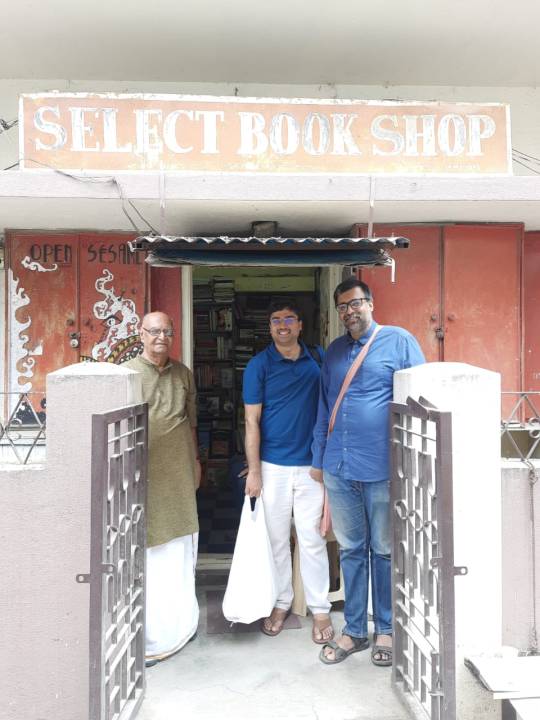
Ambi (my uncle, Dr. Koti Sreekrishna) visited India earlier this year and even stayed with me for a few days. I had a great time with him, discussing everything from the ridiculous to the sublime—often through the course of a meal in a nearby restaurant. I also had the chance to drag two of my friends (Arjun and GS) to meet Ambi and his elder brother Kanna (my uncle, Sri K Srinivas) at their ancestral house. The conversations, mostly revolving around the the great epics of India, were memorable (with some of it secretly captured on video and clandestinely posted on Facebook by Ambi).

My cousin Arun visited India in August and stayed with me. It had been years since we had met and there was so much to talk about. It was really inspiring to see his focus and his ability to grasp new ideas. I introduced him to a bunch of my friends and we all had a memorable time. Cousin Anita could not visit and was sorely missed, but she had just had a baby (my second nephew, Jayanth).
Arjun and I visited Mysore to meet Dr. S L Bhyrappa, who graciously invited us to lunch with him. Following that, we proceeded to Pandavapura to meet Mr. Anke Gowda, who has the largest personal collection of books that I have seen (over 1 million books). We were thrilled to visit his library as he enthusiastically showed us around. He has been collecting books for some seven decades with his meagre salary, driven by intense passion and devotion to literature.

Through the course of the year, in addition to the regular meet-ups with my friends, gurus, and family, I had the opportunity to meet a host of interesting people: Sri Prafulla Ketkar (Chief Editor, Organiser), Sri Shivaswami (Bhagavad-gītā scholar), Dr. Manohar Shinde (Founder, Dharma Civilization Foundation), Dr. Shekhar Borgaonkar (my father's college classmate and old friend), Dr. Kanniks Kannikeswaran (musician-composer-educator), and the dedicated people who run Rashtrotthana Vidya Kendra at Hagaribommanahalli, among others.
#
It is a co-incidence that the year began with a trip to Ellora and just as 2023 came to an end, during the course of our Madhya Pradesh road-trip, the first destination was Ellora. It was wonderful to visit that puṇya-kṣetra twice in a calendar year.

In addition to visiting Solapur, Sambhajinagar, Pune, Mumbai, Karwar, and Chennai, I went to Valparai (Tamil Nadu) for our annual boys' trip, with more friends joining the fray:
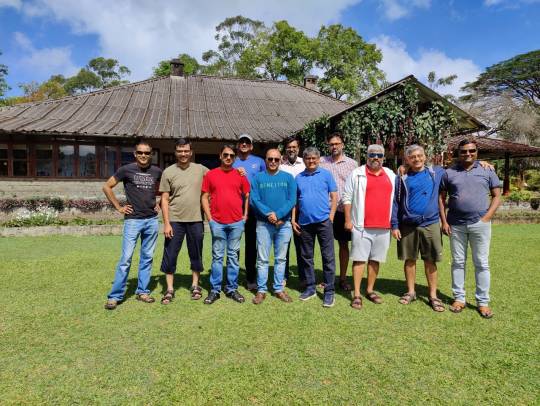
I spent the last days of the year on the road: traversing 3,800+ kilometres (Bangalore-Ellora-Maheshwar-Indore-Ujjain-Vidisha/Sanchi-Udayapur-Khajuraho-Bedaghat-Bangalore) in nine days with five of my friends and a shoe-string budget.

Among the many highlights of the trip was visiting Ahalyabai Holkar Smarak at Maheshwar.

To see her humble dwelling and to contrast that with her unparalleled achievements was an inspiration. These are the real heroes of our land and it is a sin to forget them.
#
Sri C R Sathya, the grandson of Prof. A R Krishnasastri and a remarkable space scientist (and writer) in his own right died earlier this year. He had been a great support during the time I co-translated The Essential Mahabharata. Not many people know that the gentleman on the right side of this iconic photo by Henri Cartier-Bresson is C R Sathya:

A few other greats who breathed their last in 2023 include Sri Siddeshwar Swamiji; the great gamaki Sri Chandrashekar Kedilaya; Wayne Shorter, the legendary jazz saxophonist; Sri B K S Varma, the painter par excellence; and iconic filmmaker Sri K Viswanath. I had the great fortune of meeting and interacting with both B K S Varma and K Viswanath some years ago.
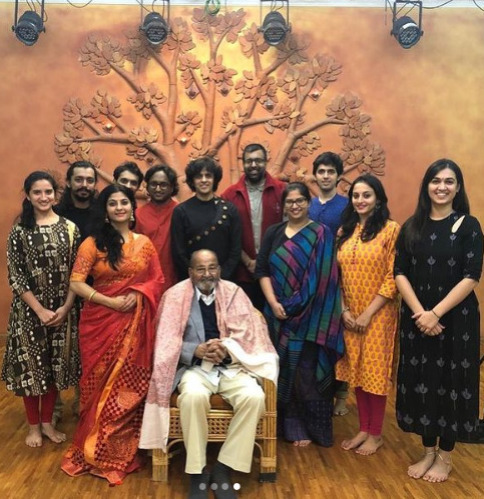
#
The changes around us end up affecting us in some way, directly or indirectly, unless of course we are really cut off and have isolated ourselves from society. In this vein, it might be instructive to broadly look at some of the events from 2023.
India has marched forward under the visionary leadership of Sri Narendra Modi, who has never failed to impress with his tireless striving for a better future.
India is now the most populous country with a host of internal problems, largely fuelled by predatory ideologies, be it the clashes between the Kuki and the Meitei or the Nuh violence or even the denigration of Sanātana-dharma, which is the most inclusive religio-philosophical system in the world. Despite this and some of the self-inflicted wounds to the economy, the country witnessed the manner in which challenges were masterfully met, be it the organisation of the spectacular G20 or the rescue of 41 miners trapped in the Uttarakashi tunnel, be it seamlessly shifting to the new parliament building or sending Chandrayaan III to the moon.
After the demonic attack that took place on October 7th, 2023, the world is slowly realising the danger of the bloodthirsty death cult masquerading as a religion. More and more countries are rejecting the pseudo-liberal ideologies of the left and are instead moving far right, which is also dangerous in its own way. Coupled with this, we are unsure of the impact of Artificial Intelligence on the future of humans. And somewhere amidst all this chaos, unknown men are quietly doing their work. And that brings me a great deal of peace.
#
Thanks for reading this far, and with this I wish you and your family a wonderful new year! I hope it will be filled with joy, good health, prosperity, and moments to cherish. May your dreams come true!
—
Appendix
I wish to share some of the fantastic accomplishments of a few people in my circle. It is, as always, an ad hoc list that I have prepared on the spur of the moment. I might have missed out some but those that I have listed are certainly notable:
Brahmin Genocide is an important topic researched by Sri Balaji Mahalingam (who writes under the pseudonym Asi) that brings to the fore an injustice that has pervaded our society in the last couple of centuries and must be immediately rectified if Hinduism is to survive. The first edition of the book was sold out in just a few months and he is now working on the second edition.
The seventh century CE Sanskrit play Bhagavad-ajjukam was documented by Nirupama and Rajendra with support from Sudha Murty, Śatāvadhānī Dr. R Ganesh, Praveen D Rao, Arjun Bharadwaj, et al.—see the Introduction and the complete play (with subtitles).
Bhāratīya Kṣāttra Paramparā (Hindi translation by Prof. Dharmaraj Singh Vaghela)
Earlier this year, when the book Kṣāttra was released, I gave a copy of the book to my uncle Prof. Vaghela. The very next day, he called me and said that it is an important book which must reach the Hindi heartland and offered to translate it into Hindi. Dr. Ganesh immediately gave his consent. In a matter of months, he finished the translation, which is now appearing on www.prekshaa.in as a series and will soon be published in book form.
My good friend and former colleague Arjun Bharadwaj has come out with two remarkable books this year: the first, titled Nayana-Savana (co-written with Śatāvadhānī Dr. R Ganesh), which is a creative appreciation of some of the major productions of the legendary Dr. Padma Subrahmanyam and the second, titled Indian Perspective of Truth and Beauty in Homer’s Epics, which is worthy of a D.Litt. no less.
S R Ramaswamy's latest work titled Sāhitya Sānnihitya is an anthology of book reviews and writings on literature.
Saṃskṛti is a reprint of a charming little book on culture with essays by littérateurs including Devudu Narasimha Shastri, A N Murthy Rao, A N Krishna Rao, Masti Venkatesha Iyengar, and C K Venkataramayya.
Prekshaa Pratishtana has brought out a lovely introductory video that summarises its vision and objectives. They continue to publish many books every year and maintain an ad-free online journal (www.prekshaa.in) with authentic content on Indian heritage for one and all.
My cousin Arun Prasad continues to do remarkable work with Ambuda, the online digital library for Sanskrit.
The best of Śatāvadhānī Dr. R Ganesh's writings in Kannada have been compiled in two volumes with the title Rāga-bhāratī.
Dr. G Sudesh Kumar, a close family friend, recently authored a coffee-table book titled History of Sri Parakala Mutt.

2 notes
·
View notes